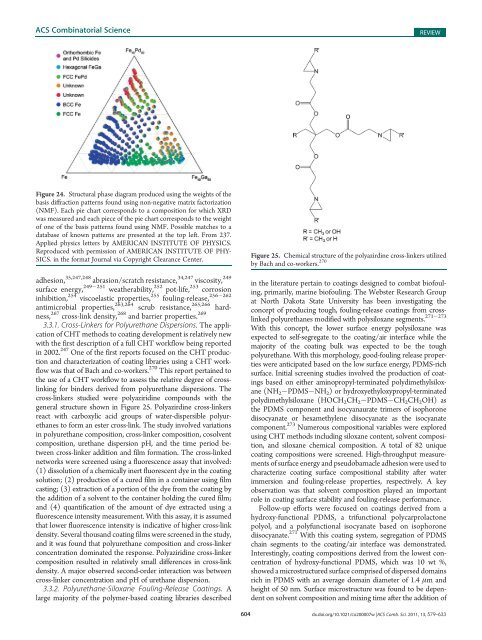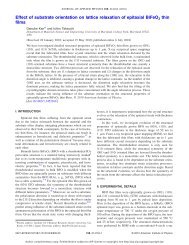Combinatorial and High-Throughput Screening of Materials ...
Combinatorial and High-Throughput Screening of Materials ...
Combinatorial and High-Throughput Screening of Materials ...
Create successful ePaper yourself
Turn your PDF publications into a flip-book with our unique Google optimized e-Paper software.
ACS <strong>Combinatorial</strong> Science<br />
REVIEW<br />
Figure 24. Structural phase diagram produced using the weights <strong>of</strong> the<br />
basis diffraction patterns found using non-negative matrix factorization<br />
(NMF). Each pie chart corresponds to a composition for which XRD<br />
was measured <strong>and</strong> each piece <strong>of</strong> the pie chart corresponds to the weight<br />
<strong>of</strong> one <strong>of</strong> the basis patterns found using NMF. Possible matches to a<br />
database <strong>of</strong> known patterns are presented at the top left. From 237.<br />
Applied physics letters by AMERICAN INSTITUTE OF PHYSICS.<br />
Reproduced with permission <strong>of</strong> AMERICAN INSTITUTE OF PHY-<br />
SICS. in the format Journal via Copyright Clearance Center.<br />
adhesion, 35,247,248 abrasion/scratch resistance, 34,247 viscosity, 249<br />
surface energy, 249 251 weatherability, 252 pot-life, 253 corrosion<br />
inhibition, 254 viscoelastic properties, 255 256 262<br />
fouling-release,<br />
antimicrobial properties, 263,264 scrub resistance, 265,266 hardness,<br />
267 cross-link density, 268 <strong>and</strong> barrier properties. 269<br />
3.3.1. Cross-Linkers for Polyurethane Dispersions. The application<br />
<strong>of</strong> CHT methods to coating development is relatively new<br />
with the first description <strong>of</strong> a full CHT workflow being reported<br />
in 2002. 247 One <strong>of</strong> the first reports focused on the CHT production<br />
<strong>and</strong> characterization <strong>of</strong> coating libraries using a CHT workflow<br />
was that <strong>of</strong> Bach <strong>and</strong> co-workers. 270 This report pertained to<br />
the use <strong>of</strong> a CHT workflow to assess the relative degree <strong>of</strong> crosslinking<br />
for binders derived from polyurethane dispersions. The<br />
cross-linkers studied were polyaziridine compounds with the<br />
general structure shown in Figure 25. Polyazirdine cross-linkers<br />
react with carboxylic acid groups <strong>of</strong> water-dispersible polyurethanes<br />
to form an ester cross-link. The study involved variations<br />
in polyurethane composition, cross-linker composition, cosolvent<br />
composition, urethane dispersion pH, <strong>and</strong> the time period between<br />
cross-linker addition <strong>and</strong> film formation. The cross-linked<br />
networks were screened using a fluorescence assay that involved:<br />
(1) dissolution <strong>of</strong> a chemically inert fluorescent dye in the coating<br />
solution; (2) production <strong>of</strong> a cured film in a container using film<br />
casting; (3) extraction <strong>of</strong> a portion <strong>of</strong> the dye from the coating by<br />
the addition <strong>of</strong> a solvent to the container holding the cured film;<br />
<strong>and</strong> (4) quantification <strong>of</strong> the amount <strong>of</strong> dye extracted using a<br />
fluorescence intensity measurement. With this assay, it is assumed<br />
that lower fluorescence intensity is indicative <strong>of</strong> higher cross-link<br />
density. Several thous<strong>and</strong> coating films were screened in the study,<br />
<strong>and</strong> it was found that polyurethane composition <strong>and</strong> cross-linker<br />
concentration dominated the response. Polyaziridine cross-linker<br />
composition resulted in relatively small differences in cross-link<br />
density. A major observed second-order interaction was between<br />
cross-linker concentration <strong>and</strong> pH <strong>of</strong> urethane dispersion.<br />
3.3.2. Polyurethane-Siloxane Fouling-Release Coatings. A<br />
large majority <strong>of</strong> the polymer-based coating libraries described<br />
Figure 25. Chemical structure <strong>of</strong> the polyazirdine cross-linkers utilized<br />
by Bach <strong>and</strong> co-workers. 270<br />
in the literature pertain to coatings designed to combat bi<strong>of</strong>ouling,<br />
primarily, marine bi<strong>of</strong>ouling. The Webster Research Group<br />
at North Dakota State University has been investigating the<br />
concept <strong>of</strong> producing tough, fouling-release coatings from crosslinked<br />
polyurethanes modified with polysiloxane segments.<br />
271 273<br />
With this concept, the lower surface energy polysiloxane was<br />
expected to self-segregate to the coating/air interface while the<br />
majority <strong>of</strong> the coating bulk was expected to be the tough<br />
polyurethane. With this morphology, good-fouling release properties<br />
were anticipated based on the low surface energy, PDMS-rich<br />
surface. Initial screening studies involved the production <strong>of</strong> coatings<br />
based on either aminopropyl-terminated polydimethylsiloxane<br />
(NH 2 PDMS NH 2 ) or hydroxyethyloxypropyl-terminated<br />
polydimethylsiloxane (HOCH 2 CH 2 PDMS CH 2 CH 2 OH) as<br />
the PDMS component <strong>and</strong> isocyanaurate trimers <strong>of</strong> isophorone<br />
diisocyanate or hexamethylene diisocyanate as the isocyanate<br />
component. 273 Numerous compositional variables were explored<br />
using CHT methods including siloxane content, solvent composition,<br />
<strong>and</strong> siloxane chemical composition. A total <strong>of</strong> 82 unique<br />
coating compositions were screened. <strong>High</strong>-throughput measurements<br />
<strong>of</strong> surface energy <strong>and</strong> pseudobarnacle adhesion were used to<br />
characterize coating surface compositional stability after water<br />
immersion <strong>and</strong> fouling-release properties, respectively. A key<br />
observation was that solvent composition played an important<br />
role in coating surface stability <strong>and</strong> fouling-release performance.<br />
Follow-up efforts were focused on coatings derived from a<br />
hydroxy-functional PDMS, a trifunctional polycarprolactone<br />
polyol, <strong>and</strong> a polyfunctional isocyanate based on isophorone<br />
diisocyanate. 271 With this coating system, segregation <strong>of</strong> PDMS<br />
chain segments to the coating/air interface was demonstrated.<br />
Interestingly, coating compositions derived from the lowest concentration<br />
<strong>of</strong> hydroxy-functional PDMS, which was 10 wt %,<br />
showed a microstructured surface comprised <strong>of</strong> dispersed domains<br />
rich in PDMS with an average domain diameter <strong>of</strong> 1.4 μm <strong>and</strong><br />
height <strong>of</strong> 50 nm. Surface microstructure was found to be dependent<br />
on solvent composition <strong>and</strong> mixing time after the addition <strong>of</strong><br />
604 dx.doi.org/10.1021/co200007w |ACS Comb. Sci. 2011, 13, 579–633












